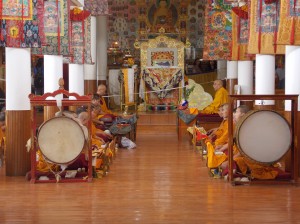While most international media have given their attention to the recent cases of immolations by Tibetan monks, Beijing-based Tibetan writer Woeser has argued that a more imminent disaster in Lhasa has been largely ignored. Early this month Woeser protested online against commercial developments in her hometown. In what she described as ‘an unpardonable and incalculable crime against the ancient city of Lhasa’s landscape, human culture and environment’, she exposed construction plans which threaten the heart of the Old City (parts of which date back to the 7th century). The post quickly went viral on Weibo before being taken down by censors.
The Exile Tibetan Administration (CTA) has since expressed its own deep concern over the ‘so-called face-lift project’ and over 1000 people including 100 international scholars in fields of Tibetan studies have signed a petition, addressed to Xi Jinping, the Chinese President, and the director-general of UNESCO, Irina Bukova, calling for a halt to the destruction.
The development project in question is Barkhor Mall which, according to its developer, once finished will cover an area of 150,000 sq m and have more than 1,000 parking spaces. According to the CTA, China is investing over 196 million US Dollars to upgrade ‘infrastructure’ in the area. These plans involve ‘thoroughly clearing’ the circumambulation path around Jokhang, Tibet’s holiest shrine. Irreplaceable structures that in some cases have stood for centuries are being destroyed to create what seems to be a commercialised tourist village.
‘Lhasa doesn’t exist only for tourists’ Woeser told the South China Morning Post. ‘There are real people who live here and it’s also a religious place. You can’t just turn it into a Sanlitun village.’ Sanlitun village is a high-end popular shopping destination in Beijing. The scholars’ petition further claims that these actions will ‘deprive Tibetans and scholars of Tibet alike of a living connection to the Tibetan past’ and ‘combined with regulations that effectively restrict pilgrimage to Lhasa…alter the role that Lhasa has played in Tibetan life for more than a millennium.’
Woeser laments how ‘pilgrims from the far borders prostrating themselves and lighting tens of thousands of butter lamp offerings every day’ will give way to ‘snipers poised on the roofs of Tibetans’ homes, and fully armed soldiers on patrol…the opening of one massive government-business sector joint venture shopping mall after another, each with inflatable blood-red plastic columns before their doors, flaunting the vulgarity and invasiveness of these new upstart operations.’
The destruction of ancient structures has been an ongoing process in Lhasa for many years. Andre Alexander, a German who worked with the Tibet Heritage Foundation to restore Old Lhasa has claimed that ‘from 1993 on, each year an average of 35 historic structures have been demolished. At this rate the remaining historic structures will have vanished in less than 4 years.’ They were able to complete remarkable restoration work and rescue 76 traditional structures from 1996 until 2002 when they were expelled from Tibet as their work and the witness they bore went against the interests of the authorities. Now, Alexander writes, ‘Each time I go (back), the old houses are clearly fewer, stone by stone, brick by brick, alley by alley, street by street; even the dogs are going missing.’
This destruction comes hand-in-hand with the forced displacement of large numbers of local Tibetans from their homes. ‘All of the residents originally living along the street are to be moved to Tolung Dechen County in the western suburb of Lhasa; those households that move quickly can get a subsidy of between 20,000 and 30,000 RMB. Not moving will be a political problem.’ Woeser writes.
Concerns have also been raised over the environmental aspect of the developments. Scholars have claimed that they are ‘wreaking ecological harm as the Kyichu (Lhasa) River dries up, as unrestrained mining and industrial operations in the region pollute it, and as ongoing construction depletes groundwater in Lhasa.’
The scholars’ petition and a recent press statement by the Exile Tibetan Administration have both called upon UNESCO and the Chinese authorities to dispatch independent investigative teams to Lhasa to report in detail on the situation. The CTA renewed its calls for the UNESCO to include Jokhang and Barkhor area in the World Heritage List while the petition asked that UNESCO provide ‘a clear-cut plan outlining what needs to be done immediately to preserve the Old City of Lhasa, to halt the current destruction.’






 Print
Print Email
Email